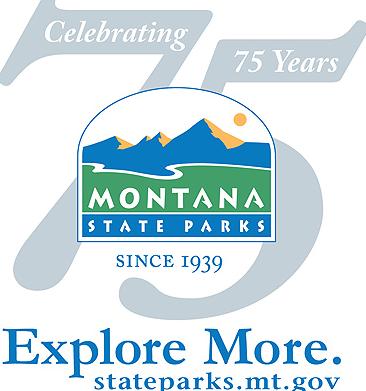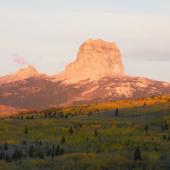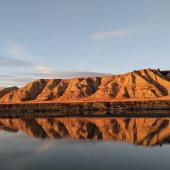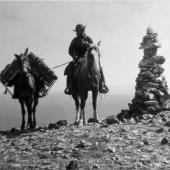Montana In 30 Years: State and National Parks
Interview with Chas Van Genderen, Administrator of Montana State Parks
Can you describe what visiting Montana’s parks might be like in 2044? How will the user experience be different?
In 2044, I will hopefully be a ‘young’ 83 year-old, with a lot more time to enjoy the outdoors. Looking ahead three decades is challenging. This year Montana State Parks is celebrating our 75th Anniversary and you could say that as an organization, we’ve been doing some soul-searching, looking back at our great history while working with the public and our partners in recreation on a new strategic planning process to carry us through the next 10 years, as we work to address longstanding challenges.

When asked to describe what visiting Montana’s state parks might be like in 30 years,
expect it will be improved with many of the same great experiences Montanans enjoy today. I bet there will also be new opportunities and new types of recreation experiences to participate in. What’s great about our state park system is that we can enjoy what our grandparents enjoyed years ago — the same landscapes, the trails they hiked, the streams they fished, and opportunities to learn about our state’s history.
We really are an affordable way to escape the daily stresses of life and leave the computer behind. We aim to preserve, protect, and improve these same places so our grandkids can make good family memories like generations before.
How will the user experience be different?
That is difficult to predict. Hopefully, in 30 years, Montana State Parks will have more stable funding so the public’s recreation interests will be well met. I could see more activities and services, such as more campsites — maybe privately operated, zip lines at parks, more wireless accessibility, more public/private partnerships, and additional activities where families can learn and explore. Finally, I anticipate we will have fewer boundaries between city, county, state, and federal agencies in managing public lands.
Are the challenges the same for state and our national parks? In what ways do they differ?
In many respects, the challenges are the same. According to Montana’s 2014 Outdoor Recreation Plan, both national and state parks struggle with funding and adequate staffing levels, plus maintenance backlogs while visitation continues to increase and infrastructure ages.
When it comes to public lands and outdoor recreation, the public really does not understand the difference between federal or state agencies; they simply want to have fun and know that our public lands and outdoor recreation resources are well managed.
One key difference is that while the National Park Service brand is well known, there is a lack of knowledge about the Montana State Parks’ brand and all that we represent. We are working on getting the word out. For example, we manage seven National Historic Landmarks and additional great historic treasures, along with providing excellent places for Montanans and out-of-state visitors to go hiking, fishing, swimming, camping, boating, picnicking, and learning about nature and the outdoors in our 54 state parks.
What would you say are the three most critical issues facing the Montana park system?
We have a long track record of limited funding and staffing.
In 2012, the Legislature compared Montana’s State Parks to others in the Rocky Mountain West, and we largely came out in last place for staffing and funding. That surprises many people because, this is Montana! Montana is about public lands and the outdoors.
In 2013, the legislature passed a bill to create a citizen board to work on that topic so we are very hopeful some hard public policy questions can be answered like: How do Montana’s want to define a state park? Should it be two buildings in a ghost town or should it be a large park like Makoshika in Glendive? What should the level of development be for a state park? How do we fund our state park system and at what level?
Aside from the operational and fiscal challenges of the park system, the biggest issue facing all natural and cultural resources is actually relevance to future generations.

What if public lands are not relevant to citizens 30 years from now? What if tomorrow’s generation does not enjoy the value of outdoor recreation and appreciate the history of it enough to preserve it?
Consider that our youth, and ourselves to some extent, are increasingly “plugged in”, insulated and removed from an outdoor lifestyle and the experiences that provides. It is why all the pictures we show and put into our promotional campaigns have people, our visitors, in them. People are part of, and integral to, the landscape now and into the future.
The implications are significant and it is part of the reason state parks are encouraging people to “Explore More”. Last year we hosted educational tours and interpretive talks to more than 26,800 students and saw a record high visitation of more than 2.1 million visits to our 54 state parks.
I hold great hope that our future leaders and staff along with the public we serve will work hard to see these trends continue. While I am concerned about future relevance for public lands and resources across our country in coming years, I believe Montanans’ hold support for their natural and cultural heritage as a core value. I expect state parks will continue to grow in use and public value. When you have a group of professionals as dedicated to serving our visitors and our resources as our Montana State Park’s staff is today, it is hard to be anything but optimistic for the future.
Chas Van Genderen has been the Administrator for Montana State Parks since 2009. He has made preservation and promotion of Montana’s natural, cultural, and recreation heritage top priorities. Chas’ experience in Parks and Recreation spans nearly three decades. Working for Montana State Parks since 1998, Chas received a 2014 ‘Our Montana’ Leadership Award, a 2014 ‘Visionary Award’ from Parks’ Division staff, and the 2012 Governor’s Award, an additional special recognition for his outstanding leadership. His leadership has been instrumental in sustaining and growing revenues through vehicle registration, implementing an online campsite reservations program, working with the legislature to develop the new Montana State Parks & Recreation Board and much more. Chas lives in Helena with his wife, Liz. They have two college-aged daughters. He is an avid hunter and angler and an all-around outdoor enthusiast.
For More About Montana State Parks follow this link: stateparks.mt.gov












Leave a Comment Here